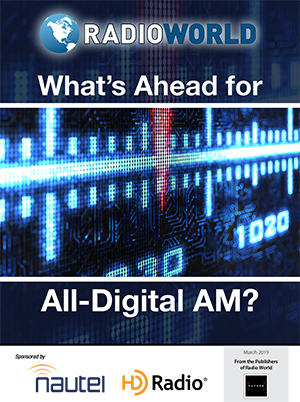 In a recent ebook, Radio World explored the implications of allowing all-digital operation on the AM band in the United States. Here’s an excerpt in which the late Ron Rackley shared his thoughts on the idea, prior to his April 12 death. Read the ebook here. Also, readers are invited to send a letter to the editor on this or any subject.
In a recent ebook, Radio World explored the implications of allowing all-digital operation on the AM band in the United States. Here’s an excerpt in which the late Ron Rackley shared his thoughts on the idea, prior to his April 12 death. Read the ebook here. Also, readers are invited to send a letter to the editor on this or any subject.
Veteran engineer Ron Rackley was principal at the consulting firm duTreil, Lundin & Rackley. He enthusiastically endorsed the idea of allowing licensed all-digital over-the-air broadcasting on the AM band in the United States. Prior to his April 12 death, he answered our questions with a focus on technical and regulatory matters.
Rackley (who with colleague Ben Dawson was described in 2006 by the NAB as “icons in the field of AM broadcast antenna system design and development”) said of all-digital, “It makes full realization of the efficiency of high-quality digital transmission possible. It will be far more robust than the simulcasting of digital and analog transmission on AM channels that has been tried and pretty much discarded by the industry.”
Rackley believed the modulation standards of the FCC rules could be modified easily to regulate digital-only transmission.
“They should be focused on taking advantage of digital technology to reduce inter-station interference in a way that is not possible with the analog modulation standards being fundamentally incompatible with the 10 kHz channel spacing scheme, as is the case today,” he said.
“I believe that much can be accomplished in that regard if digital subcarriers are to be transmitted within the existing 10 kHz channels by themselves — without the need to manage their interaction with simultaneously transmitted analog signals.”
[“We Look Forward to the Day of All-Digital AM”]
What technical obstacles would be raised?
“I believe that the analog transmission standards should be modified to do away with the NRSC requirements with regard to pre-emphasis, and that analog audio transmission should be limited to 5 kHz audio to facilitate the design of compatible standards for adjacent-channel protection between analog and digital-only transmissions,” he said.
“Analog pre-emphasis could be unregulated and stations would occupy their 10 kHz wide channels — which would encourage an octave or so increase in analog receiver frequency response while at the same time making it possible to have digital-only neighbors.
“I say that there would be an octave or so increase in received analog response because the average AM receiver today is limited to approximately 2.5 kHz or less audio reception to deal with adjacent-channel interference that is inherent in the present transmission standards,” he continued.
“If AM stations are limited to 5 kHz transmission, the receivers could have 5 kHz reception without adjacent-channel interference. It would be a win-win, with room being made for digital-only transmission and an improvement in analog reception at the same time.”
[All-Digital AM, Breaking New Ground]
What about the idea of using the expanded band as a way to “ease into” all-digital?
“I believe that rules should be written to treat all AM frequencies the same with regard to digital-only transmission,” Rackley replied.
“Instead of creating a separate band to encourage initiate digital transmission for stations that operate in analog mode successfully, any roadblock in the rules that limit how many stations one company can have in a market should be eliminated to encourage simultaneous digital transmission while keeping the analog programming on the air.”
He said a station could acquire or LMA another station in the market to carry its present programming digitally, with the goal of having both modes available during the transition period.
“Then, as the listenership to the digital signal eclipses that of the analog transmitter — assuming digital ‘catches on’ — a decision could be made to migrate the digital signal to the transmitter with the best ‘footprint’ over the market until such time as the analog signal can be turned off.”







